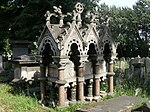Ladbroke Grove railway station
CrossrailProposed railway stations in LondonUse British English from December 2016
Ladbroke Grove is a proposed railway station in London, England on the Crossrail Route between Old Oak Common and Paddington. This is not part of the internal route and would be added at a later stage. Locals want the station to be called Portobello Central to serve the nearby Portobello Market. It was originally called Kensal.
Excerpt from the Wikipedia article Ladbroke Grove railway station (License: CC BY-SA 3.0, Authors).Ladbroke Grove railway station
London North Kensington (Royal Borough of Kensington and Chelsea)
Geographical coordinates (GPS) Address Nearby Places Show on map
Geographical coordinates (GPS)
| Latitude | Longitude |
|---|---|
| N 51.52618 ° | E -0.2225 ° |
Address
W10 5DW London, North Kensington (Royal Borough of Kensington and Chelsea)
England, United Kingdom
Open on Google Maps








